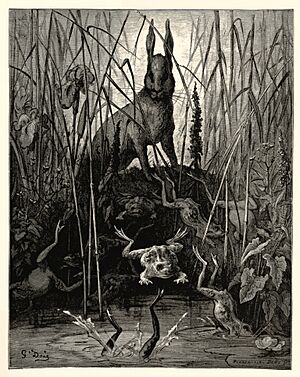The Frightened Hares facts for kids
Hares are often seen as shy animals, and many old stories, called fables, have been written about this. One of the most famous is "The Hares and the Frogs." It's part of Aesop's Fables, a collection of ancient tales. This story is also known in other cultures and has been told in different ways over many years.
Contents
Fables About Hares and Fear
Many fables show hares being easily scared. One very old story from Buddhist scriptures, called the Duddubha Jataka, is about a hare who starts a big panic. When a fruit falls, the hare thinks the whole Earth is falling apart! This makes all the other animals run away in fear. This story led to an old saying in India: "the sound the hare heard," which means something impossible. A similar Western story is "Henny Penny," where a chicken thinks "the sky is falling."
The Hares and the Frogs Fable
In Aesop's fable, "The Hares and the Frogs," the panic is smaller. There are different versions of this story. In some, the hares get scared by the sound of wind in the leaves. In others, they have a meeting and decide their lives are so full of danger that they should just jump into a river.
As they run towards the river, they scare some frogs on the bank. The frogs all jump into the water to escape! Seeing this, a smarter hare stops the group. He points out that if there are creatures who can be scared by hares, then the hares' lives can't be as bad as they thought.
Different Versions of the Story
Around the year 1190, a writer named Marie de France retold the story in her book Ysopet. In her version, the hares decide to move to a new place. But when they see frogs jumping into a pond to get away from them, the hares realize something important. They understand that no matter where they go, they will always find some fear, work, or sadness.
A Jewish writer from around the same time, Berechiah ha-Nakdan, told a similar story. His group of hares, trying to leave their home, were even scared by the sound of frogs croaking at night. They decided to just go back home.
Lessons from the Fable
In the 1500s, a writer named Hieronymus Osius wrote two poems about this fable. He compared the hares' fear to human suffering. He noted that most people don't truly want to die. His shorter poem suggested that learning to overcome our fears is an important part of growing up.
A Dutch version of the tale by Eduard de Dene was titled "A stout heart is the remedy for fear." This version gave the story a religious meaning. The artist for that book, Marcus Gheeraerts the Elder, made a woodcut picture of the story. This picture was later used on a special plate called a trencher. Around the edge of the plate, a short message reminded people to fear harm to their soul more than harm to their body. About a hundred years later, in 1668, La Fontaine's Fables also told this classic story in a very elegant way.
During the Middle Ages, some people who wrote about this fable said it teaches us to be happy with what we have. This idea was also shared in a collection by Robert Dodsley and later in Thomas Bewick's illustrated book of The Fables of Aesop in 1818. That book ended with a poem that said:
-
- The miseries of half mankind unknown,
- Fools vainly think no sorrows like their own;
- But view the world and you will learn to bear
- Misfortunes well, since all men have their share.
This means that when you see what others go through, you realize your own problems might not be so bad. It also teaches us to feel for others who are suffering. A writer named Pantaleon Candidus came to the same conclusion in his retelling of the story in the early 1600s.
Hares in Art and Music
The fable "The Hares and the Frogs" has also inspired artists and musicians. A Czech composer named Ilja Hurník set a translation of the fable to music. It was the final piece in his work called Ezop, written in 1964, for a choir and orchestra.


